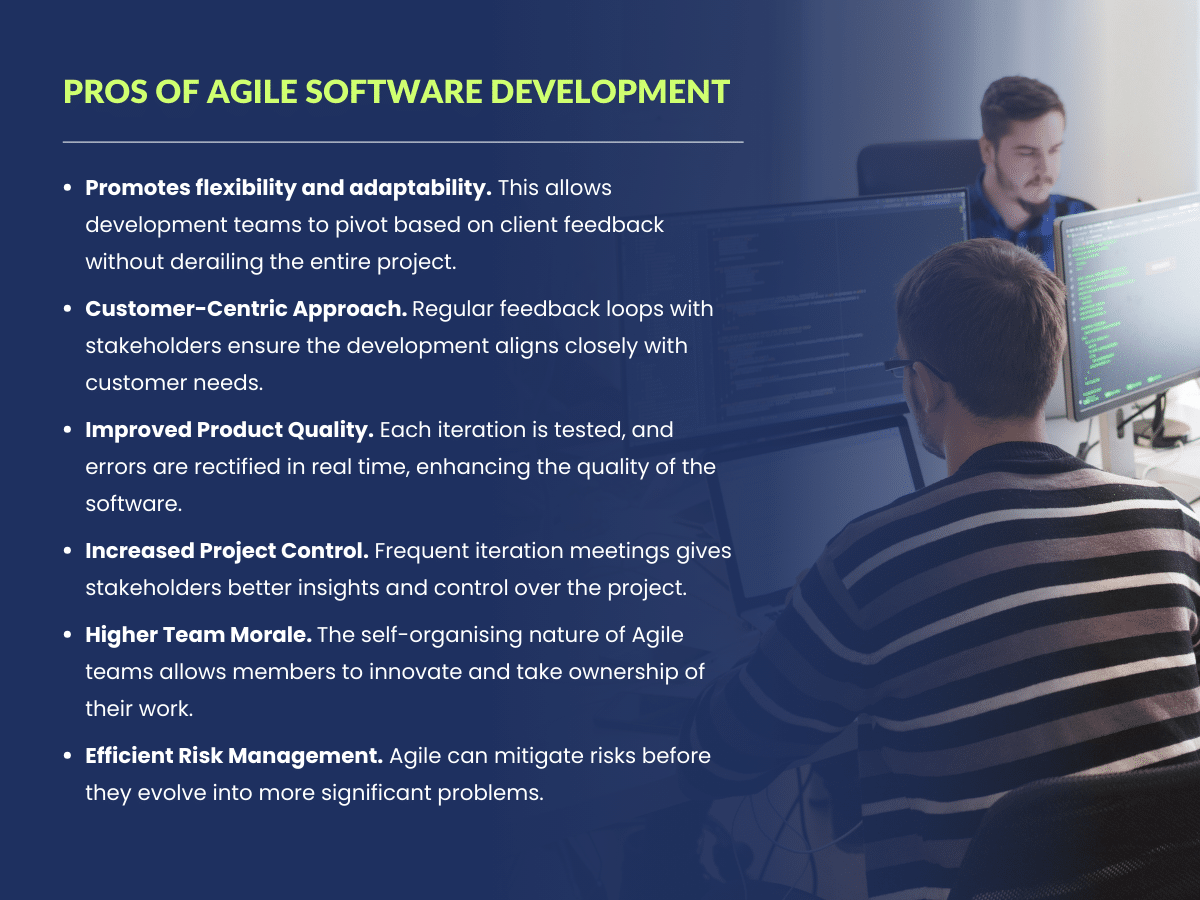Agile software development has revolutionised how teams create and manage software projects for years. It has offered many companies and developed teams a flexible and adaptive approach. This framework allowed teams to respond to changing requirements quickly, ensuring that the final product aligns with customer needs and delivers high-quality outcomes.
But the question is: What really is Agile?
In this article, we will explore the fundamentals of Agile software development, its core principles, popular methodologies, and the pros and cons associated with its adoption.
What is Agile Software Development?
According to its manifesto, Agile Software Development is a methodology used for the iterative and incremental development of software products. It emerged in response to the limitations of traditional software development methods, such as the Waterfall model, which often lacked flexibility and customer involvement.
As such, this method allows teams to adapt to changes quickly and efficiently, ensuring the final product meets the evolving needs of its users.
What are the Core Principles of Agile Software Development?
The core principles of Agile software development are outlined in the Agile Manifesto Ⓒ 2001. The manifesto is built around four foundational values and twelve supporting principles that are intended to guide Agile development and decision-making in Agile projects.
Four Foundational Values

- Individuals and Interactions Over Processes and Tools. Agile methodologies give importance to people and collaboration over strict adherence to tools or processes. This value highlights the belief that effective communication among team members and stakeholders are crucial to successful software development.
- Working Software Over Comprehensive Documentation. While traditional methodologies often prioritise extensive documentation, Agile focuses on delivering functional software as a priority. This value supports the idea that a working product is more beneficial to the client than detailed paperwork, promoting iterative development and regular feedback.
- Customer Collaboration Over Contract Negotiation. Agile encourages ongoing interaction and partnership with the customer throughout the development process. This ongoing dialogue helps ensure that the end product more accurately reflects the customer’s needs and can adapt to changes more fluidly.
- Responding to Change Over Following a Plan. The ability to adapt to changes during the development process is more valued in Agile than rigidly sticking to a set plan. This value acknowledges that flexibility can lead to better project outcomes and innovations.
Twelve Principles

In relation, the manifesto also outlines 12 core principles that are aimed at improving the development process.
- Customer Satisfaction through Early and Continuous Delivery. Deliver working software frequently, from a couple of weeks to a couple of months, with a preference for a shorter timescale.
- Welcome Changing Requirements. Even late in development, Agile processes harness change for the customer’s competitive advantage.
- Deliver working software frequently, from a couple of weeks to a couple of months, with a preference for the shorter timescale. Teams can build a product incrementally to deliver working software frequently.
- Business People and Developers Must Work Together Daily. Agile emphasises daily cooperation between business stakeholders and developers, ensuring alignment and shared project ownership.
- Build Projects around Motivated Individuals. Give them the environment and support they need, and trust them to get the job done.
- The Most Efficient and Effective Method of Conveying Information. Face-to-face conversation is the most efficient and effective method of conveying information to and within a development team.
- Working Software is the Primary Measure of Progress. Functional software is the primary measure of progress toward the project’s goals.
- Agile Processes Promote Sustainable Development. The sponsors, developers, and users should be able to maintain a constant pace indefinitely.
- Continuous Attention to Technical Excellence and Good Design. Attention to technical excellence and design improves agility as it enhances adaptability.
- Simplicity. Maximising the amount of work not done is essential, focusing efforts only on what is necessary.
- Self-organising Teams. The best architectures, requirements, and designs emerge from self-organising teams.
- Regularly Reflect and Adjust. At regular intervals, the team reflects on how to become more effective, then tunes and adjusts its behaviour accordingly.
What are the Common Agile Software Development Methodologies?
Several frameworks fall under the Agile umbrella, each with its own unique approach but sharing the core Agile principles:
Scrum
Scrum is perhaps the most widely implemented Agile Software Development framework. It aims to help teams work together to develop, deliver, and sustain complex projects through iterative and incremental delivery. This framework works in sprint cycles, which typically lasts two weeks to a month.
Here are the key components of a scrum team that must be fully understood.
- Product Owner. Responsible for maximising the product’s value from the Development Team’s work. They manage the product backlog and ensure everyone understands the work items.
- Scrum Master. They act as a coach to the team, helping the members use the Scrum process to perform at the highest level. The Scrum Master also helps remove impediments and foster an environment where the team can be effective.
- Development Team. A group of professionals who deliver the product. They are cross-functional, meaning they have all the skills necessary to create product increments and are self-organising.
Kanban
Kanban is a popular Agile methodology that focuses on lean principles and a visual approach to managing work. Originating from the Japanese word for “visual signal” or “card,” this agile method was initially developed by Toyota in the 1940s to improve manufacturing efficiency. It has since been to manage work efficiently at a personal or team level, particularly in software development and other business areas.
Kanban uses a board with columns representing the stages of the workflow. Common columns include “To Do,” “In Progress,” and “Done.” Cards or sticky notes representing tasks move from left to right as work progresses through stages. The board acts as a live document of the team’s workflow and helps quickly communicate the status of different tasks.
Extreme Programming (XP)
Extreme Programming (XP) is an Agile software development framework that aims to improve software quality and responsiveness to changing customer requirements. This Agile methodology emphasises high customer involvement, rapid feedback loops, continuous testing, planning, and close teamwork to deliver higher-quality software at more frequent intervals.
XP is particularly effective in projects with dynamic requirements, high risks, and the need for frequent releases. As a result, it is widely adopted in startups and other environments that value innovation and adaptability.
Lean
Lean software development is an adaptation of lean manufacturing principles and practices to the software development domain, heavily influenced by the Agile methodology. It originates from the Toyota Production System, which focused on increasing efficiency by eliminating waste.
Likewise, lean software development aims to optimise the efficiency of software development processes, improve quality, and deliver value to customers faster. This software development method aligns well with Agile model by emphasising customer value, team empowerment, and efficiency. It is suited to any development environment where reducing time to market is a priority and where customer needs continuously evolve.
What are the Pros and Cons of Agile Software Development?
Since its foundation, Agile software development has transformed the landscape of project management and software production. For years, it has offered numerous advantages while presenting certain challenges.
That said, here are some pros and cons of adopting Agile methodologies:
Pros of Agile Software Development

- Promotes flexibility and adaptability. As mentioned, agile software development is highly adaptable to changes in project requirements, even late in the development process. This flexibility allows teams to pivot based on client feedback or shifts in market conditions without derailing the entire project.
- Customer-Centric Approach. As discussed, agile strongly emphasises customer involvement and satisfaction. Regular feedback loops with stakeholders ensure the development aligns closely with customer needs, leading to higher customer satisfaction and products that meet user demands.
- Improved Product Quality. Agile’s iterative nature allows for continuous testing and refinement of the product. Each iteration is tested, and errors are rectified in real time, greatly enhancing the overall quality of the software.
- Increased Project Control. Frequent iteration meetings and updates provide more visibility into the project’s progress. This transparency gives stakeholders better insights and control over the project, facilitating more informed decision-making.
- Higher Team Morale. Agile methodologies often promote a more collaborative and empowering work environment for teams. The self-organising nature of Agile teams allows members to innovate and take ownership of their work, which can improve engagement and job satisfaction.
- Efficient Risk Management. Since Agile involves frequent iterations and constant feedback, risks are identified and addressed in a timely manner. This allows teams to mitigate risks before they evolve into more significant problems.
Cons of Agile Software Development

- Scope Creep. Due to its iterative nature and openness to changing requirements, Agile projects can suffer from scope creep. Without careful management, continuous changes can lead to project delays and budget overruns.
- High Demand for Customer Involvement. The success of an Agile project often hinges on the client’s ability to participate actively. This constant involvement can be demanding and sometimes impractical if stakeholders are not fully committed or available.
- Less Predictability. Agile’s flexibility can sometimes make the project’s direction less predictable. The absence of a fixed scope and the potential for frequent pivots can complicate resource allocation and long-term planning.
- Initial Learning Curve and Adoption Challenge. Transitioning to Agile from more traditional methodologies like Waterfall can be challenging for teams. The shift requires a significant change in mindset, processes, and often the organisational culture, which can be a steep learning curve for many.
- Not Suitable for All Projects. Agile may not be the best fit for all types of projects. For example, projects that require a high degree of up-front design and regulatory compliance or those with fixed requirements and scope are less suited to the flexibility of Agile.
- Reliance on Strong Team Dynamics. Agile requires highly collaborative teams with strong interpersonal skills. In environments where team members are not co-located, or there are significant skill gaps, the collaborative approach of Agile can be less effective.
Conclusion
In conclusion, agile software development offers a dynamic and responsive approach that has transformed the software development process. It enables teams to deliver high-quality products that align with evolving customer needs.
However, it also presents challenges, such as the risk of scope creep and the need for strong team dynamics and customer involvement. Despite these challenges, Agile’s ability to foster innovation and improve project outcomes makes it a valuable methodology for various industries.
If you want to implement Agile methodologies or enhance your current practices, contact Flexisource IT for expert guidance and tailored solutions that can transform your software development lifecycle. Visit our contact page to get started.





